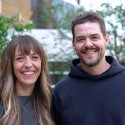Feminism in health care subject of new UW-Madison research
Control the body, control the person.
During the last 40 years, feminists have insisted that the ability to make their own decisions about their own bodies provided a — if not the — crucial foundation for achieving true equality for women.

Students in a women’s studies community health class discuss birth control during a class in the mid-1980s. Participants include nurse practioner Candace Weber, second from left. The UW–Madison Women’s Studies Program celebrated its 30th anniversary in October. Originally growing out of the women’s movement of the 1970s, the program now has 26 faculty and offers classes in 13 academic departments this semester.
Photo: courtesy Women’s Studies Program
Judith A. Houck, assistant professor for medical history and bioethics, is beginning new research on the history of feminist health activism in the United States between 1969-93.
She predicts that it will be a complicated journey, since there were — and are — several different and sometimes-competing perspectives on and goals for women’s health.
“Despite general agreement about the need for medical reform, feminists did not share a common vision of health care. For example, some activists wanted to avoid the male dominated medical profession entirely. They promoted female self-help and health facilities controlled by lay staff. Other feminists acknowledged that the medical profession had much to offer women, but sought to establish health facilities that embraced feminist principles. Movement leader Barbara Seaman even proposed in 1975 that only women should be licensed as obstetricians and gynecologists, and that all research on women should be carried out exclusively by women,” Houck says.
Nor could feminists agree about the nature of their bodies:
“Health activists Barbara Ehrenreich and Deirdre English said that feminists seemed to alternate between accusing the medical system of treating women as though they were sick as a ramification of being women, and accusing them of not appreciating how sick they really were,” Houck says.
In addition, she says that as time went on, the “women’s health movement” further complicated matters by splintering into subgroups defined by racial or sexual identity.
“Smaller movements such as the National Black Women’s Health Project, founded in 1983, and the Lesbian Health Foundation, established in 2000, indicate the failure of a movement trying to further the interests of all women,” Houck says.
Nevertheless, she says that a loosely structured and defined women’s health movement did begin to crystallize, centered around three overlapping missions.
“As health educators, feminists published books and articles, gathered and analyzed information, sponsored workshops, promoted consciousness raising, and designed and taught courses, such as Women and Their Bodies in Health and Disease, taught at UW–Madison since 1975. As lobbyists, health feminists challenged the safety of devices and medications, such as the Dalkon Shield and oral contraceptives. They also urged medical schools to accept more women and encouraged more women to apply, and demanded funding for research that addressed issues and conditions disproportionately affecting women. As direct health service providers, activists performed abortions, taught self-help gynecology, and, as physicians, opened their own health clinics,” she says.
The emergence of women-only clinics in the 1970s illustrates a key philosophical point in the broader feminist debate, Houck says.
“Then, as now, some feminists claimed that their bodies made them different from men, while others insisted that women are essentially the same as men despite difference in their bodies. This divide forms the contours of the women’s health movement. These fissures reveal the myth of the universal woman,” says Houck.
She adds that her project will bring women’s health activism into larger discussions about medical history, women’s history and cultural anatomical history.
“Most significantly, I think, is the fact that this project will bring the history of women’s bodies and attitudes toward them into our emerging understanding of contemporary feminism,” she says. “I think this research will show that many women connect with feminism, sometimes tentatively, sometimes enthusiastically, through their bodies. For many women, feminism only spoke to them as they confronted the patronizing attitudes of their gynecologists or heard about the dangers of the Dalkon Shield. Others came to feminism after they tried to get an abortion, or found out they had been sterilized against their will.
“The project also will show how a generic women’s health movement sometimes ignored economic, sexual or ethnic differences among women — these differences often created distinct bodily needs. For example, some lesbian activists protested the reproductive health focus of many of the early feminist clinics.”
Houck will pursue her research as a fellow in the Institute for Research in the Humanities. A book will be forthcoming when she completes the research, she says.
Tags: research




